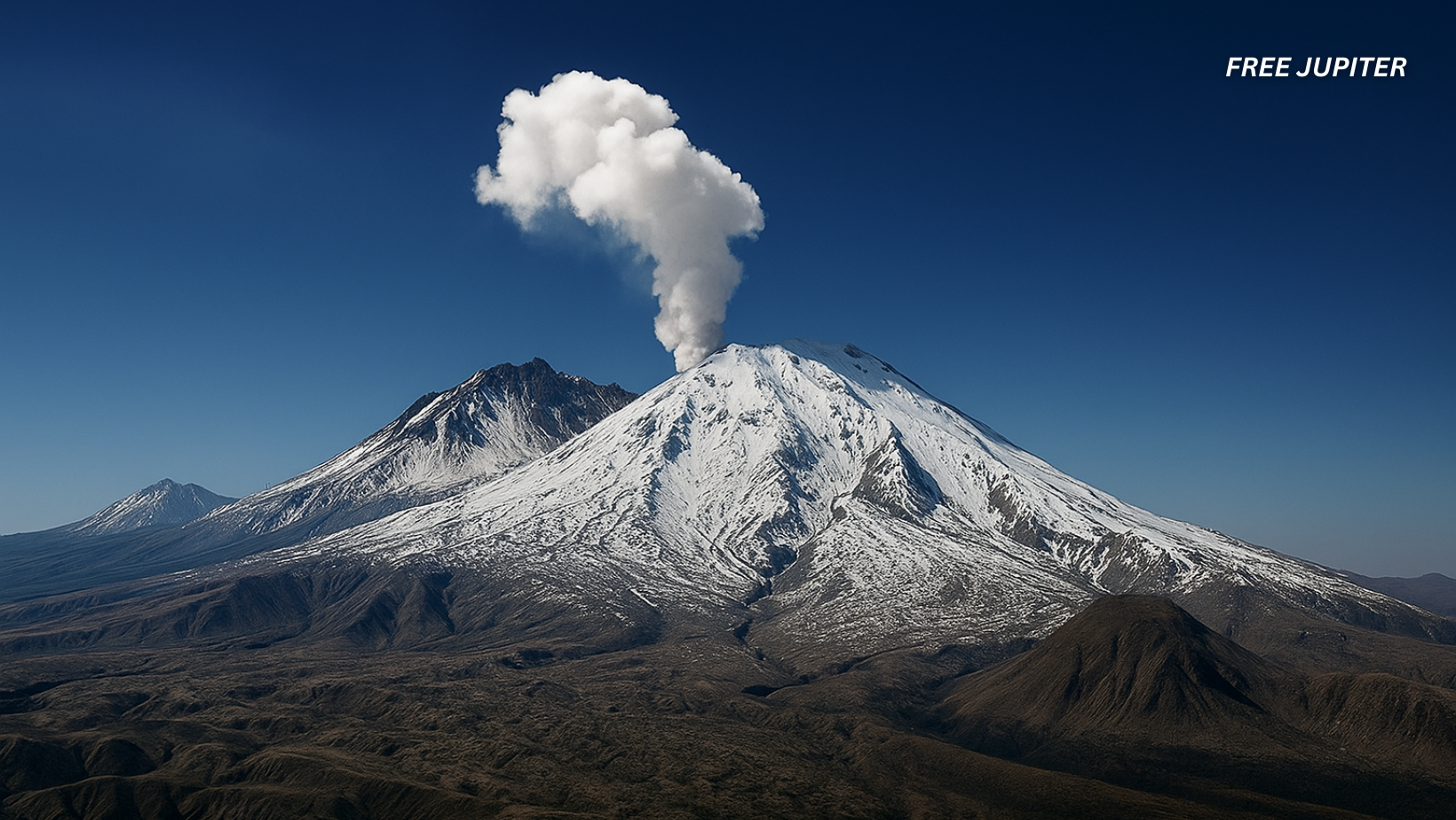Deep in southeastern Iran, a long-silent volcano has begun to move again — ever so slightly. Over the course of just 10 months, the Taftan volcano has lifted itself upward by about 3.5 inches (roughly 9 centimeters). That may sound trivial, but in the world of volcanoes, small movements often whisper big stories.
A recent scientific study using satellite radar data revealed this subtle but meaningful rise. Researchers say it’s a clear sign that pressure is quietly building beneath the mountain — an early hint that Taftan’s slumber might be lightening.
Watching from Space: The Power of Satellite Eyes
Taftan is a remote and rugged volcano, far from major cities and largely inaccessible for direct observation. Because few people live close enough to monitor it with ground-based instruments, scientists turned to space for help.
Using a method called InSAR (Interferometric Synthetic Aperture Radar), researchers tracked the mountain’s surface movements from orbit. The Sentinel-1 satellites, operated by the European Space Agency, can capture ground shifts with incredible precision — day or night, rain or shine, and even through thick clouds.
Read more: Science Finally Answers If We Can Stop A Volcano From Erupting Or Not
Between July 2023 and May 2024, these satellites observed the volcano’s summit slowly lifting. Unlike a balloon that deflates, the ground has not sunk back, which strongly hints that whatever caused the rise — likely pressure or gas buildup — has not yet been released.
According to lead researcher Pablo J. González from the Spanish National Research Council’s Institute of Natural Products and Agrobiology (IPNA), this movement is worth paying attention to. “It’s not a reason for panic,” González explained, “but it’s a reason for preparation.”
What’s Happening Beneath the Surface?
Computer models suggest that the source of this uplift lies about 1,600 to 2,000 feet (roughly 500 to 630 meters) below the surface — surprisingly shallow for a volcano. That’s a zone where hot gases and water circulate through cracks in the rock, creating what geologists call a hydrothermal system.
To make sure the signal was truly volcanic, scientists checked other possible causes, such as heavy rainfall or local earthquakes. Neither fit the pattern. The movement occurred smoothly over several months and slowed naturally, consistent with underground gases shifting and expanding rather than an external event.
Far deeper, at around 2 miles (3.2 kilometers) below ground, lies Taftan’s magma reservoir — a massive pocket of molten rock. However, the current signs don’t point to magma rising toward the surface. Instead, it appears that gases sitting above the magma are building pressure, pushing the ground upward much like steam lifting the lid of a pot.
The Misleading “Extinct Volcano” Label
Taftan stands tall at 12,927 feet (3,940 meters), a classic stratovolcano shaped by layers of hardened lava and ash. While it hasn’t erupted in recorded human history, that doesn’t mean it’s truly dead. Its summit still releases gases through fumaroles — small vents that hiss with steam and sulfur — a sure sign that heat still flows beneath.
The term “extinct volcano” can be deceptive. Many volcanoes remain quiet for thousands or even hundreds of thousands of years before waking again. Geological silence isn’t the same as geological death.
Volcanoes like Taftan often send subtle signals long before they erupt: tiny earthquakes, gas emissions, or slow ground movements like the one recently detected. This is why scientists focus not only on ash clouds but also on small, gradual changes that hint at internal restlessness.
Read more: NASA Captures Stunning Image Of Massive Mars Volcano Piercing Through The Ice Cloud Belt
Pressure Without Magma: The Likely Explanation
So what exactly is lifting the mountain? The simplest answer is gas pressure.
When gases like carbon dioxide, sulfur dioxide, and steam build up in the cracks and pores of rocks, they can gently push the ground above them. This can happen without any molten lava making its way upward. Another possibility is a minor pulse of magma deeper below that released gases into shallower layers, which then expanded and caused the surface to bulge.
Both explanations fit the observations: the gradual rise, the plateau, and the lack of major earthquakes or surface cracks. The movement seems to have slowed down recently, suggesting that some of the trapped gases might have found new escape routes.
Still, scientists caution that this doesn’t mean the system is safe — only that it’s dynamic. Pressure always finds a way out, whether through a gentle release of gas or something more forceful.
Potential Risks: Steam, Not Lava
If Taftan does decide to make a move, it’s unlikely to produce flowing lava anytime soon. The greater risk comes from phreatic eruptions — sudden, steam-driven explosions that occur when superheated water flashes into vapor near the surface.
Such blasts can send rock fragments flying and release plumes of gas and ash, though they’re usually short-lived. For nearby communities, the main hazards would be sulfurous gases that can irritate the eyes, lungs, and crops downwind.
The nearest city, Khash, sits about 31 miles (50 kilometers) from Taftan’s peak — close enough for residents to occasionally smell sulfur when the wind shifts.
González emphasized that now is the time for awareness, not alarm. “The volcano will eventually release that pressure, one way or another,” he said. “The goal is to understand when and how, so we can prepare before it happens.
Understanding Taftan’s Place on Earth’s Map
Taftan sits on a subduction zone, where one tectonic plate slides beneath another — a setting famous for creating volcanoes. As the descending plate melts, it generates magma that feeds volcanoes from below, while volatile gases move upward through cracks.
The mountain’s two main peaks and long-lived vents show that it’s still geothermally active. In fact, many volcanoes around the world exhibit this same pattern: slow, steady changes that rarely lead to eruptions but remind us that they’re very much alive beneath their calm surface.
Read more: Trees Can Actually Warn Us When Volcanos Are Ready to Erupt
Why Satellites Are Game-Changers
One reason scientists can monitor remote volcanoes like Taftan at all is thanks to modern satellites. Radar-based systems can see through clouds and smoke and operate 24/7, unaffected by weather or darkness.
The Sentinel-1 satellites orbit Earth frequently enough to capture movements just a few inches wide. These data are stitched together into time-lapse “movies” that reveal how a volcano’s surface subtly rises and falls.
As more satellites are launched, the frequency of these observations increases, allowing scientists to catch changes in near real time. Combined with ground instruments, this two-pronged approach gives the clearest possible picture of what’s happening below.
Looking Ahead: Reading the Volcano’s Next Move
If Taftan’s ground begins to sink, that could mean the pressure is easing and gases have safely vented. But if the uplift continues — or accelerates — it would suggest pressure is still building, raising the likelihood of steam-driven activity.
A sudden spike in gas emissions or small local earthquakes would be another red flag. Scientists plan to test whether the volcano’s internal “plumbing” — its network of cracks and chambers — has loosened or tightened. That will help predict how large the next pressure release could be.
For those living nearby, the advice is simple: stay informed, know evacuation routes, and keep masks handy in case sulfur odors become strong. Preparation and awareness are always better than surprise.
Read more: Why Earth Is the Only Known World In The Universe Where Fire Burns
The Takeaway
Taftan’s story isn’t about panic — it’s about patience and preparation. After 700,000 years of near silence, this ancient volcano is finally sending subtle signals that it’s awake again.
Most volcanoes do this quietly for decades without erupting, but tracking these whispers helps scientists spot trouble early. As González puts it, “It’s better to listen to the mountain while it’s whispering than wait for it to shout.”
The study detailing Taftan’s gentle awakening was published in Geophysical Research Letters — a reminder that even the quietest corners of our planet are never truly still.
Featured image: Taftan Volcano. GPT 5o Re-creation.
Friendly Note: FreeJupiter.com shares general information for curious minds. Please fact-check all claims and double-check health info with a qualified professional. 🌱










